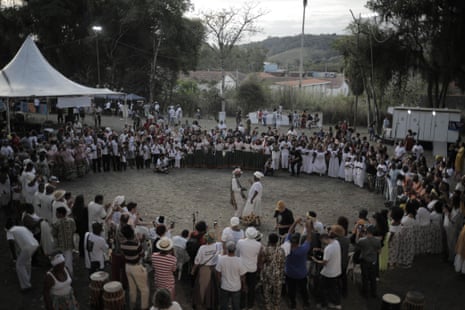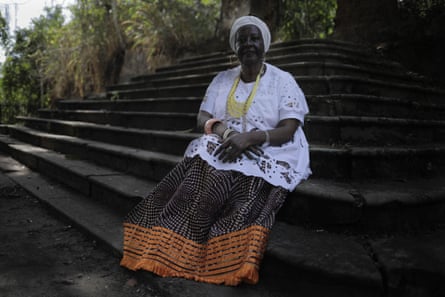A coffee plantation in Brazil enslaved Africans. Centuries later, their descendants have taken over
"São José do Pinheiro once stood out for its lavishness. Now a public space, it hosts a museum and a school of jongo, a tradition of music, dance, spirituality and storytelling

Two hundred years ago, the São José do Pinheiro coffee plantation farm, 120km (75 miles) away from Rio de Janeiro, was one of the most opulent estates in Brazil.
Even for the country that received the highest number of kidnapped Africans during the transatlantic slave trade, the property was one of a kind.
About 500 people – an unusually big workforce even by Brazilian standards – were enslaved by one of Brazil’s richest men, José de Souza Breves, who owned eight other estates in the region.
Pinheiro was his headquarters, and it stood out for its lavishness, with a 20-room palace filled with artworks and a 48-bed hospital for the enslaved workers – a way to prevent productivity declines due to sickness or harsh injuries.
Now, Pinheiral, a town of 24,000 people named after the farm, occupies the area where it once stood.
Remnants of the palace – pieces of columns and walls covered in graffiti and surrounded by dense vegetation – have become a public space named the Park of the Ruins.
And what was once the headquarters of a slaveholding empire has been claimed by descendants of those who were once forced to work there.

They recently secured funding from the Brazilian government to transform Ruins Park into a museum and school of jongo, an Afro-Brazilian tradition that mixes music, dance, spirituality and storytelling.
“We fought hard to reclaim a land that once belonged to a slaver, but now it’s ours,” said jongueira Cintia Helena da Silva, 34, whose ancestors were enslaved at Pinheiro.
“I have been involved with jongo since I was little. My grandmother was a master, then my mother, my uncles; and now I bring my husband and my son,” she said, pointing to little three-year-old Derick Abayomi.
Da Silva’s family is part of the Jongo de Pinheiral group, which, through an agreement with the town hall, took control of the space in 2016 and now runs the museum project.

On a recent weekend, the group organised a festival featuring 18 different jongo groups at Pinheiro on the same vast, flat terrain where, in the 1800s, coffee beans were spread out to dry under the sun.
The proceedings were opened by Maria de Fátima da Silveira Santos, 68, whose rings, bangles, bracelets and necklaces evidenced her authority as the Jongo de Pinheiral’s leader.
“I came to bless the land I step on,” sang the leader known as Mestre Fatinha.
The jongueiros formed a circle: two played the drums, while Mestre Fatinha sang a ponto, which was then followed by everyone.
The lyrics can range from seemingly mundane themes (“Keep my name out of your mouth”) to more political ones that directly mention slavery: “I was sleeping, [and the drum] called me/Get up, people, for captivity is over.”

The performances – which can take hours and sometimes all night – usually involve just two people at time, most often a man and a woman, who dance in the ring. There is no choreography; everyone dances as they wish. A few moves later, each one is replaced, one at a time.
Although it seems like a dance, it has always involved much more, said Mestre Fatinha. “Jongo was a way of communication for Black people. They engaged in politics, courted each other, worshipped the orixás [deities from the Afro-Brazilian religion Candomblé]. Everything happened in a jongo circle,” she said.


Serious issues could be discussed in songs, and even revolts could be organised in coded messages right under the eyes of the enslavers.
According to Rafael Galante, a historian and ethnomusicologist, the word “jongo” originates from the Bantu language family, to which most of the Africans brought to Brazil in the 19th century belonged.
There is no consensus on its exact meaning, but one interpretation suggests that it refers to a communal space for political, social and religious mediation.
Despite incorporating elements found in some central African cultures, jongo is a uniquely Brazilian phenomenon, the result of the “diasporic experience”, Galante said, adding: “It’s the best first-person narrative we have of the enslaved people’s perspective on slavery.”
Mestre Fatinha agrees: “Our jongo is the same as it was during the time of the plantation, and it has been passed down from generation to generation.”
Nowadays, it has also taken on a new role, she said: “It’s a banner for our struggle as Black people … Now we use it to be present at spaces like schools and universities, to talk about our traditions ourselves.”
Jongo is practiced by at least 14 traditional communities in the Brazilian south-east. Many of these are remnants of quilombos, another Bantu-origin word that, during Brazil’s 350 years of slavery, referred to communities established by escaped enslaved people.

Although jongo is not a religion, there is spirituality involved. Some songs refer to the orixásand Catholic figures including Saint Benedict the African.
“We always reference our ancestors because, if it weren’t for them, we wouldn’t be here … We dance in the memory of them,” said Mestre Fatinha, who along with the musician and artistic director Marcos André Carvalho is leading the project to transform the Pinheiro estate’s ruins into a memorial for Black people.
In addition to the museum and the jongo school, the plans include a restaurant, a visitor centre, a library and the preservation of the ruins, which have deteriorated significantly after years of neglect.
The entire project is budgeted at 5m reals (£705,844, or $890,513), but for now the Brazilian government has only approved 300,000 reals (£42,351, or $54,817) for the development of an executive project. Construction is not expected to start until next year.
“The Pinheiro estate was once one of the greatest symbols of Brazilian slavery’s opulence,” said Galante.
“And the people who survived all that violence are now claiming that space to transform it into a memory centre. No one remembers who that enslaver was, but here you are writing about jongo.”
No comments:
Post a Comment